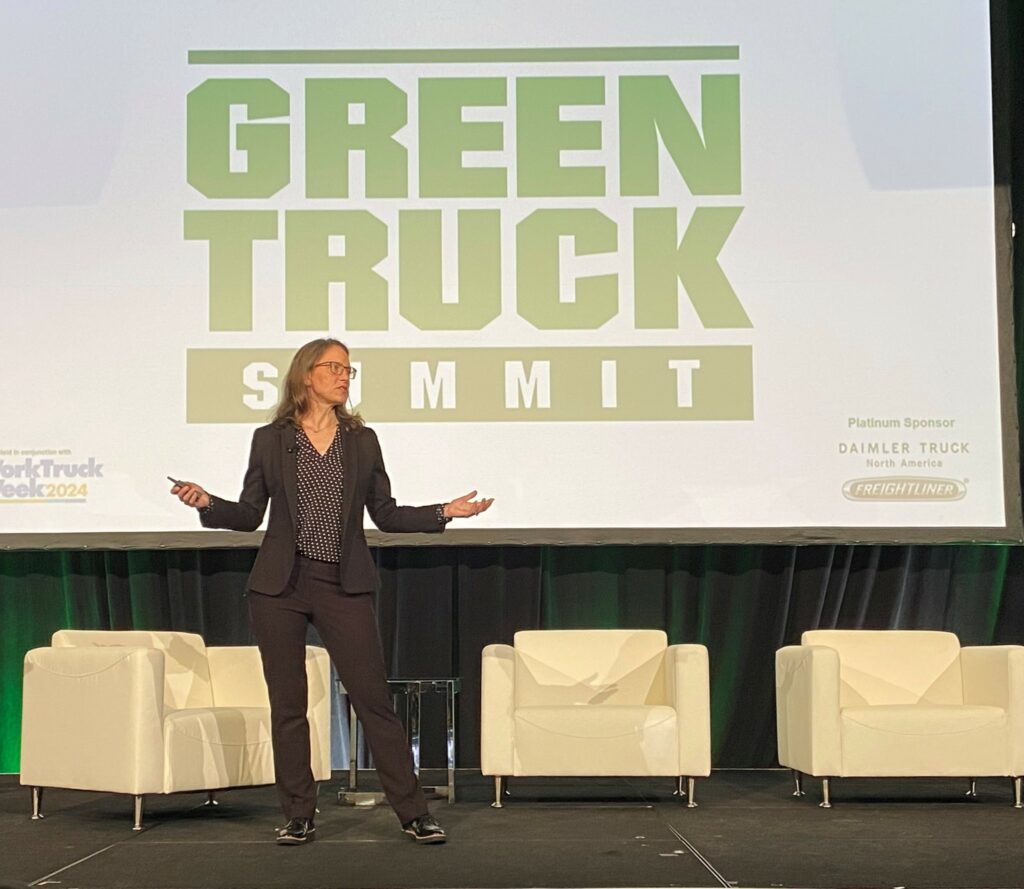Partnerships key to tackling sustainability hurdles, DTNA’s Aufdemberg says
Battery electric, hydrogen and diesel are all part of the equation for a cleaner world. Partnerships are the way forward, said Mary Aufdemberg, general manager of product strategy and market development, Daimler Truck North America, during the keynote address that kicked off Green Truck Summit in Indianapolis, Ind.
She noted that 30 years ago one truck produced more emissions than 60 trucks produced today. “In the past 15 years the emissions from semitrucks have been reduced by more than 20%, but we want to do more,” she said.
“With the complexity of vehicle types, customer needs, and ecosystem challenges there’s no easy button, but there’s a will.”

Aufdemberg said there are hurdles along the way, the biggest being lack of infrastructure and high cost. She said transformation has an equation, where viable product solutions are multiplied by total cost of ownership parity multiplied by dependable charging infrastructure.
Battery electric will be prevalent this decade, but hydrogen will become more popular toward the end of the decade as infrastructure is put in place and the cost of the fuel drops. “Right now, the cost of hydrogen much more expensive compared to electricity. And we know electricity pricing can still be a challenge as well,” she said.
Hydrogen technology
Daimler Truck has partnered with Linde Engineering in Europe to develop sub cooled liquid hydrogen refueling technology.
“As they develop the technology, it would be available to all. It’s something we want to make sure the whole industry has access to,” she added.
The technology is in the infancy stage in the U.S., but momentum will grow as hydrogen hubs are built. Aufdemberg sees a lot of promise with sub cooled liquid hydrogen for work trucks as it provides the required power.
Batteries are very expensive, and grants and incentives help spread the technology. Partnerships are also another way of tackling this challenge. She said Daimler Trucks’ partnership with Accelera by Cummins and Paccar to build a battery cell production plant in Mississippi will help onshore technology and help bring down costs.
Charging infrastructure
There are 10 public charging sites for medium and heavy-duty commercial vehicles in the U.S., compared to 60,000 sites for cars. Aufdemberg said private infrastructure is a way to deal with this daunting problem.
Compounding the issue is that there are more than 3,000 different utilities in the country.
“Every time a customer or dealer wants to start looking at putting in infrastructure the formula changes for the process, permits, costs, and availability of power.”
Aufdemberg said PACT (Powering America’s Commercial Transportation) -– teaming up with Navistar and Volvo -– is an opportunity to jointly lobby and accelerate the conversation and ensure the challenges are understood.
She added that infrastructure has to happen along with the investments made in technology for trucks to reach zero-emission goals. A larger effort needs to be made to continue down the path to sustainability.
“We don’t exactly know which technology will be in which truck by when quite yet. Compared to two years ago, there’s more trucks on the road and more public and private infrastructure going in. We are a lot smarter and we’re going to continue that momentum,” Aufdemberg said.
Have your say
This is a moderated forum. Comments will no longer be published unless they are accompanied by a first and last name and a verifiable email address. (Today's Trucking will not publish or share the email address.) Profane language and content deemed to be libelous, racist, or threatening in nature will not be published under any circumstances.
I think Ms. Aufdemberg is exactly right. There is a role for battery, diesel and hydrogen powered vehicles. It’s great seeing Daimler playing a leading role with all three!